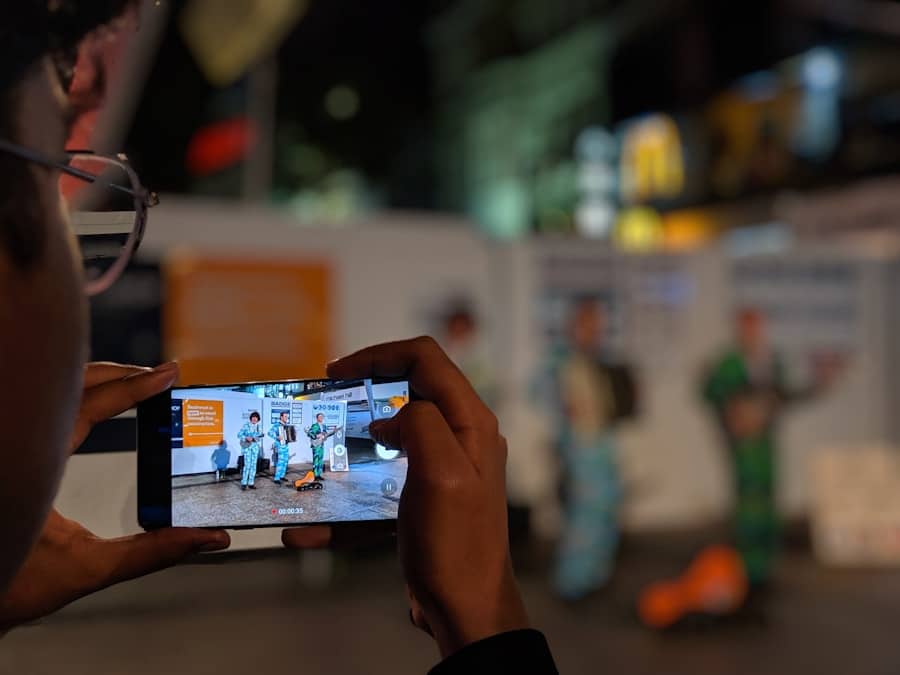The convergence of artificial intelligence (AI) and augmented reality (AR) has ushered in a new era of storytelling, transforming how narratives are crafted and experienced. Historically, storytelling has been a linear process, where authors or creators dictate the flow of the narrative. However, with the advent of AI and AR technologies, this paradigm is shifting towards a more interactive and participatory model.
AI algorithms can analyze user preferences and behaviors, allowing for personalized storytelling experiences that adapt in real-time. Meanwhile, AR enhances the narrative by overlaying digital content onto the physical world, creating a more immersive environment that engages the audience on multiple sensory levels. The rise of these technologies is not merely a trend; it reflects a fundamental change in how stories are told and consumed.
For instance, platforms like Snapchat and Instagram have popularized AR filters that allow users to interact with their surroundings in novel ways, effectively turning everyday moments into storytelling opportunities. In literature and gaming, AI-driven characters can respond dynamically to player choices, creating branching narratives that feel unique to each user. This shift towards interactivity and personalization is reshaping the landscape of storytelling, making it more engaging and relevant to contemporary audiences.
Key Takeaways
- AI and augmented reality are revolutionizing storytelling by creating immersive and interactive experiences for audiences.
- The impact of AI and augmented reality on interactive narratives is transforming the way stories are told and experienced, blurring the lines between reality and fiction.
- AI plays a crucial role in creating immersive storytelling experiences by personalizing content and enhancing user engagement.
- The integration of augmented reality in interactive narratives allows for a seamless blend of digital and physical worlds, providing a unique and interactive storytelling experience.
- Advancements in AI and augmented reality technology are continuously pushing the boundaries of storytelling, opening up new possibilities for the future of interactive narratives.
The Impact of AI and Augmented Reality on Interactive Narratives
The integration of AI and AR into interactive narratives has profound implications for both creators and consumers. Traditional narratives often follow a predetermined path, but interactive narratives powered by these technologies allow for multiple outcomes based on user decisions. AI can analyze player choices and adapt the storyline accordingly, creating a sense of agency that was previously unattainable in conventional storytelling formats.
Moreover, AR enhances this experience by providing a visual context that enriches the narrative. For example, in an AR-enhanced game, players might see characters or objects from the story materialize in their real-world environment, blurring the lines between fiction and reality.
This immersive quality not only captivates users but also encourages them to explore the narrative in ways that traditional media cannot facilitate. The combination of AI’s adaptability and AR’s immersive visuals creates a rich tapestry of storytelling possibilities that can engage audiences on multiple levels.
The Role of AI in Creating Immersive Storytelling Experiences

AI plays a pivotal role in crafting immersive storytelling experiences by enabling dynamic content generation and character development. Through natural language processing (NLP), AI can create dialogue that feels authentic and responsive to user interactions. This technology allows characters to engage in meaningful conversations with players, adapting their responses based on previous interactions and user preferences.
Such depth in character development enhances the emotional stakes of the narrative, making players feel more invested in the outcomes. Additionally, AI can analyze vast amounts of data to identify trends and preferences among audiences, allowing creators to tailor their narratives to meet specific demographic needs. For instance, an AI system might analyze user feedback from previous interactive stories to determine which plot twists or character arcs resonated most with audiences.
This data-driven approach enables storytellers to refine their narratives continuously, ensuring they remain relevant and engaging. As a result, AI not only enhances the storytelling process but also empowers creators to push the boundaries of narrative design.
The Integration of Augmented Reality in Interactive Narratives
The integration of augmented reality into interactive narratives offers a unique opportunity to blend digital storytelling with real-world experiences. By overlaying digital elements onto physical environments, AR allows users to engage with stories in ways that were previously unimaginable. For example, location-based AR applications can guide users through a city while revealing hidden narratives tied to specific landmarks or historical events.
This spatial storytelling approach encourages exploration and discovery, transforming mundane environments into rich narrative landscapes. Moreover, AR can facilitate collaborative storytelling experiences where multiple users interact with the same narrative simultaneously. In such scenarios, participants might work together to solve puzzles or complete challenges that advance the story.
This collaborative aspect not only enhances engagement but also fosters social connections among users as they share their experiences and insights. The potential for AR to create shared narrative experiences opens up new avenues for community-building around storytelling, making it a powerful tool for both creators and audiences.
Advancements in AI and Augmented Reality Technology for Storytelling
Recent advancements in AI and AR technologies have significantly enhanced their capabilities for storytelling. In AI, machine learning algorithms have become increasingly sophisticated, enabling systems to generate complex narratives that can adapt to user input seamlessly. These algorithms can learn from user interactions over time, refining their understanding of what makes a compelling story.
As a result, creators can leverage these tools to develop narratives that feel personalized and engaging. On the AR front, improvements in hardware and software have made it easier for developers to create high-quality experiences that are accessible to a broader audience. The proliferation of smartphones equipped with advanced cameras and sensors has democratized AR development, allowing independent creators to experiment with interactive narratives without needing extensive resources.
Furthermore, platforms like Unity and Unreal Engine have integrated AR capabilities into their development environments, streamlining the process for storytellers looking to incorporate augmented elements into their work.
The Future of Interactive Narratives with AI and Augmented Reality

Looking ahead, the future of interactive narratives powered by AI and augmented reality appears promising yet complex. As these technologies continue to evolve, we can expect even more sophisticated storytelling experiences that blur the lines between fiction and reality.
This shift will challenge creators to innovate continually while maintaining the core elements that make stories resonate emotionally. Moreover, as AR technology becomes more ubiquitous through devices like smart glasses or contact lenses, the possibilities for immersive storytelling will expand exponentially. Imagine walking through a city where every corner reveals a new layer of narrative tied to its history or culture—this could become a reality as AR becomes integrated into our daily lives.
However, this future also raises questions about privacy, data security, and ethical considerations surrounding user interactions with AI-driven narratives.
Challenges and Opportunities in Merging AI and Augmented Reality for Storytelling
While the merging of AI and augmented reality presents exciting opportunities for storytelling, it also comes with its share of challenges. One significant hurdle is ensuring that the technology remains accessible to creators from diverse backgrounds. As advanced tools become more prevalent, there is a risk that only those with technical expertise will be able to harness their full potential.
To counter this trend, educational initiatives aimed at democratizing access to these technologies will be crucial in fostering a diverse range of voices in interactive storytelling. Another challenge lies in balancing interactivity with narrative coherence. As stories become more complex due to branching paths influenced by user choices, maintaining a cohesive narrative thread can be difficult.
Creators must find innovative ways to guide users through these intricate narratives without sacrificing engagement or clarity. This challenge presents an opportunity for collaboration between writers, game designers, and technologists to develop new frameworks for storytelling that embrace interactivity while preserving narrative integrity.
Examples of Successful Interactive Narratives Using AI and Augmented Reality
Several successful examples illustrate how AI and augmented reality can be effectively combined to create compelling interactive narratives. One notable instance is “Pokemon GO,” which utilizes AR technology to encourage players to explore their surroundings while capturing virtual creatures. The game’s success lies not only in its innovative use of AR but also in its ability to foster community engagement through collaborative gameplay experiences.
Another example is “The Walking Dead: Our World,” an AR mobile game that immerses players in the post-apocalyptic world of the popular television series. Players must navigate real-world locations while completing missions tied to the show’s narrative. The integration of AI-driven character interactions enhances the experience by allowing players to engage with familiar characters in meaningful ways.
In literature, projects like “The Night Cafe” utilize VR and AR elements to create immersive environments based on Vincent van Gogh’s artwork. Users can explore a digital recreation of the artist’s famous café while interacting with elements inspired by his life and work. This blend of art and storytelling showcases how AR can elevate narrative experiences beyond traditional formats.
These examples highlight the potential for AI and augmented reality to revolutionize storytelling across various mediums, offering audiences new ways to engage with narratives that resonate deeply on personal levels while fostering community connections through shared experiences.
In a related article, Enicomp discusses the latest advancements in technology with their article on the best HP laptop for 2023. This article delves into the cutting-edge features and capabilities of HP laptops, showcasing how technology continues to evolve and shape our daily lives. To read more about the intersection of technology and innovation, check out Enicomp’s article on the best HP laptop for 2023.
FAQs
What is AI?
AI, or artificial intelligence, refers to the simulation of human intelligence in machines that are programmed to think and act like humans. This includes tasks such as learning, problem-solving, and decision-making.
What is Augmented Reality (AR)?
Augmented Reality (AR) is a technology that superimposes a computer-generated image on a user’s view of the real world, thus providing a composite view.
How are AI and Augmented Reality merging to create interactive narratives?
AI and Augmented Reality are merging to create interactive narratives by using AI to analyze user behavior and preferences, and then using AR to overlay interactive elements onto the user’s environment, creating a personalized and immersive storytelling experience.
What are the benefits of merging AI and Augmented Reality for interactive narratives?
The merging of AI and Augmented Reality for interactive narratives allows for personalized and adaptive storytelling experiences, increased user engagement, and the ability to create dynamic and interactive content that responds to the user’s actions and choices.
What are some examples of interactive narratives created through the merging of AI and Augmented Reality?
Examples of interactive narratives created through the merging of AI and Augmented Reality include interactive museum exhibits that adapt to the user’s interests, personalized storytelling experiences in theme parks, and interactive educational content that responds to the user’s learning style.

